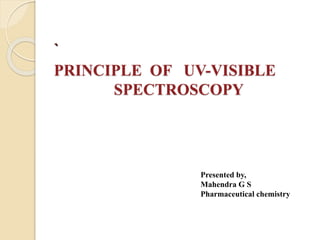
Principle of UV visible Spectroscopy
- 1. ` PRINCIPLE OF UV-VISIBLE SPECTROSCOPY Presented by, Mahendra G S Pharmaceutical chemistry
- 2. Ultraviolet (UV) region : The term ultraviolet means “beyond violet” which is derived from a Latin word “Ultra” meaning beyond. Here the radiation starts at the blue end of the visible light from 400nm and ends at 200nm. Visible region : The visible region of the electromagnetic spectrum ranges between 400-780nm.The visible light is otherwise called as white light or ordinary light and is composed of different colors as seen in a rainbow.
- 3. Spectroscopically, visible light behaves in a similar way as UV light. Hence, the techniques of UV spectroscopy and visible spectroscopy are considered together. For this reason commercial UV equipment operates between 800nm and 200nm.
- 4. On passing EMR in UV -visible regions through a compound with multiple bonds, a portion of radiation is normally absorbed by the compound. The amount of absorption deepens on the wavelength of radiation and the structure of the compound. The absorption of radiation is due to subtraction of energy from the radiation beam when electrons in orbitals of lower energy are excited into orbitals of higher energy and transitions happen thereby. Since this is an electron excitation phenomenon, UV is also called as electronic spectroscopy.
- 5. Theory of UV Spectroscopy: Energy absorbed in the UV-visible region produces changes in the electronic energy of the molecule resulting from transitions (ground state to excited state) of valence electrons in the molecule. Three distinct types of electrons are involved in organic molecules. They are as follows: a) σ electrons b) π electrons c) n electrons
- 6. σ electrons : These electrons are involved in saturated bonds, such as those between carbons and hydrogens in paraffins. These bonds as sigma (σ) bonds. They require much more energy than UV light to excite the electrons hence they are frequently used as solvents. π electrons : These electrons are involved in unsaturated hydrocarbon bonds. Eg: trienes , aromatic compounds. n electrons : These are the electrons which are not involved in the bonding between atoms in molecules. Eg: nitrogen, oxygen, halogens.
- 7. As n(valence)-electrons can be excited by UV radiation, any compound that contains atoms like nitrogen, oxygen, sulphur, halogen. compounds or unsaturated hydrocarbons may absorb UV radiation. Both π and n electrons are less firmly held than σ electrons. Thus π and n electrons requires lesser energy, generally valence(n) electrons requiring less energy than that required by π electrons. Thus Energy needed for promoting an electron follows the order: σ > π> n
- 8. Different Types of Molecular Orbitals σ* Anti-bonding π* Anti-bonding n* π σ Bonding Bonding Non-Bonding
- 9. Bonding Orbital: They directly participate in bond formation between atoms. Electrons of bonding orbital are represented as σ and π. Non-Bonding Orbital : They do not participate in bond formation. Eg : atoms such as oxygen, sulphur, nitrogen (valence electrons). Anti-Bonding Orbital : They oppose bonding and electrons do not take part in bonding. Eg : π* and σ*.
- 10. Absorption Spectroscopy in UV-visible region: It deals with the separation, detection and recording of energy changes in nuclei, atom, molecule or ion due to absorption of certain wavelengths of UV-visible light. When absorption takes place it undergoes electronic transitions. This technique is employed in pharmaceutical analysis for quantitative, qualitative and structural analysis of solvent in solution.
- 11. Types of electron transitions: Energy absorbed in the ultraviolet region by complex organic molecules causes transitions in the valence electrons in the molecules. The transitions are : a) σ---σ* c) n---σ* b) n---π* d) π--- π* When selection rules are applied, the σ---σ*, n---σ*, π---π*,transitions are usually allowed whereas n---π* transition is forbidden. Allowed transition : These transitions occur due to π---π* transition where €max is 104 or more. Forbidden transition : These transitions occur due to n---π* transitions where €max is less than 104.
- 12. Selection rules for transition: 1) For transition to take place, the energy of photons(E) must be equal to the change in energy(δE) between two electronic energy levels, E=δE.. 2) There should not be any change in the spin of electron, δS=0. 3) In very rare cases, change in spin is allowed i.e., in forbidden transition which occurs only in intramolecular or intermolecular perturbation. 4) During transition, there should not be any significant change between inter-nuclear distance.
- 13. The energy level scheme for a molecule is shown as : The energy required for excitation of different transitions are: n---π*˂ π---π*˂ n---σ*˂ σ---σ*
- 14. References : Instrumental Methods of Chemical Analysis by G.R. Chatwal and S.K. Anand, page no: 2.149 to 2.153 www.google.com